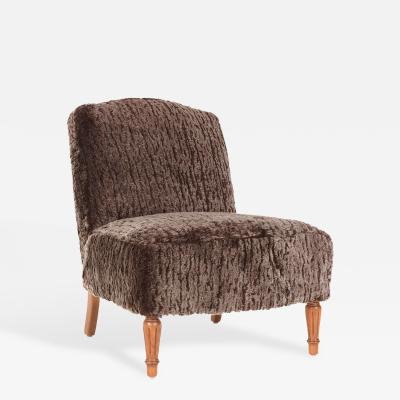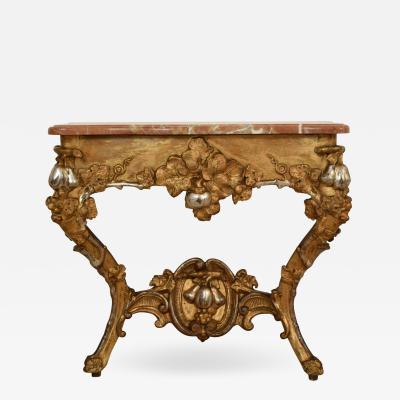The Soul of a Room
“Antiques give a room its soul, a sense of history, nuance and romance.” |
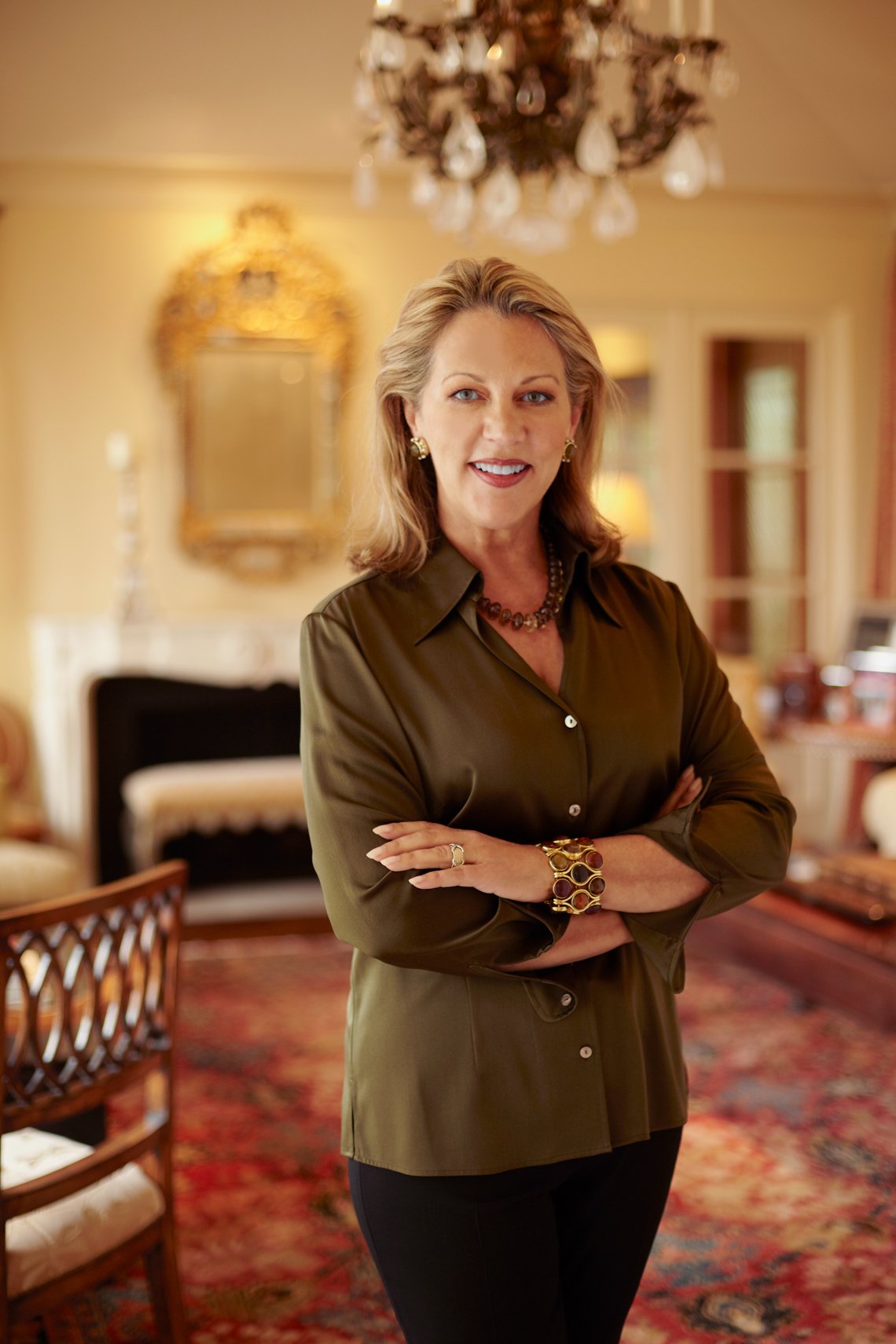 | |
Suzanne Tucker |
It was during Sotheby’s auction at El Mirador, Armour meat-packing heiress Lolita Armour Mitchell’s Montecito estate, that a teenaged Suzanne Tucker first fell in love with antiques. Sitting in the bleachers, she followed the proceedings, noting the sale price and provenance of each piece, beginning the process of training her eye and visualizing how she would place them in an interior. After obtaining a design degree from UCLA, she lived in London and worked with Peter Hood, a protégé of John Fowler, absorbing the nuances of the Colefax and Fowler/Nancy Lancaster aesthetic. Upon her return to California in the early 80s, she signed on as secretary to interior design legend Michael Taylor. Within months she accompanied him to projects, serving as his assistant, and then, as a designer in her own right, delivering the firm’s trademark “California Look.” The use of multiple shades of white; an emphasis on the effects of light; bringing the outdoors in with large plants and sometimes, even boulders; mixing antiques and modern pieces from disparate styles and ages all seem commonplace now, but were revolutionary then. Mastery of scale and proportion was perhaps the key talent Suzanne honed while working with Taylor, and as she once explained, “Scale has to do with size, proportion with balance, and when these are in harmony, the end result is comfort.” In 1986 her mentor died, and Suzanne partnered with Timothy Marks (who later became her husband), launching Tucker & Marks. The firm is a perennial on the AD100 List of Top Designers of the World, and Suzanne Tucker is a highly sought-after speaker on design and the decorative arts. Since attending the very first San Francisco Fall Art & Antiques Show with Michael Taylor in 1981, she has missed only one, and served on the Show’s advisory board and as Designer Circle Chair for many years. She established a preview night for the design industry to pre-shop for clients, and re-established the popular Designer Vignettes to illustrate how antiques can be mixed in with other elements in an interior. 2019 was her fifth year as Show Chair.
Suzanne’s passion for antiques shines through in these interiors, which showcase creative ways to incorporate them with modern art, global treasures, and contemporary upholstered pieces.
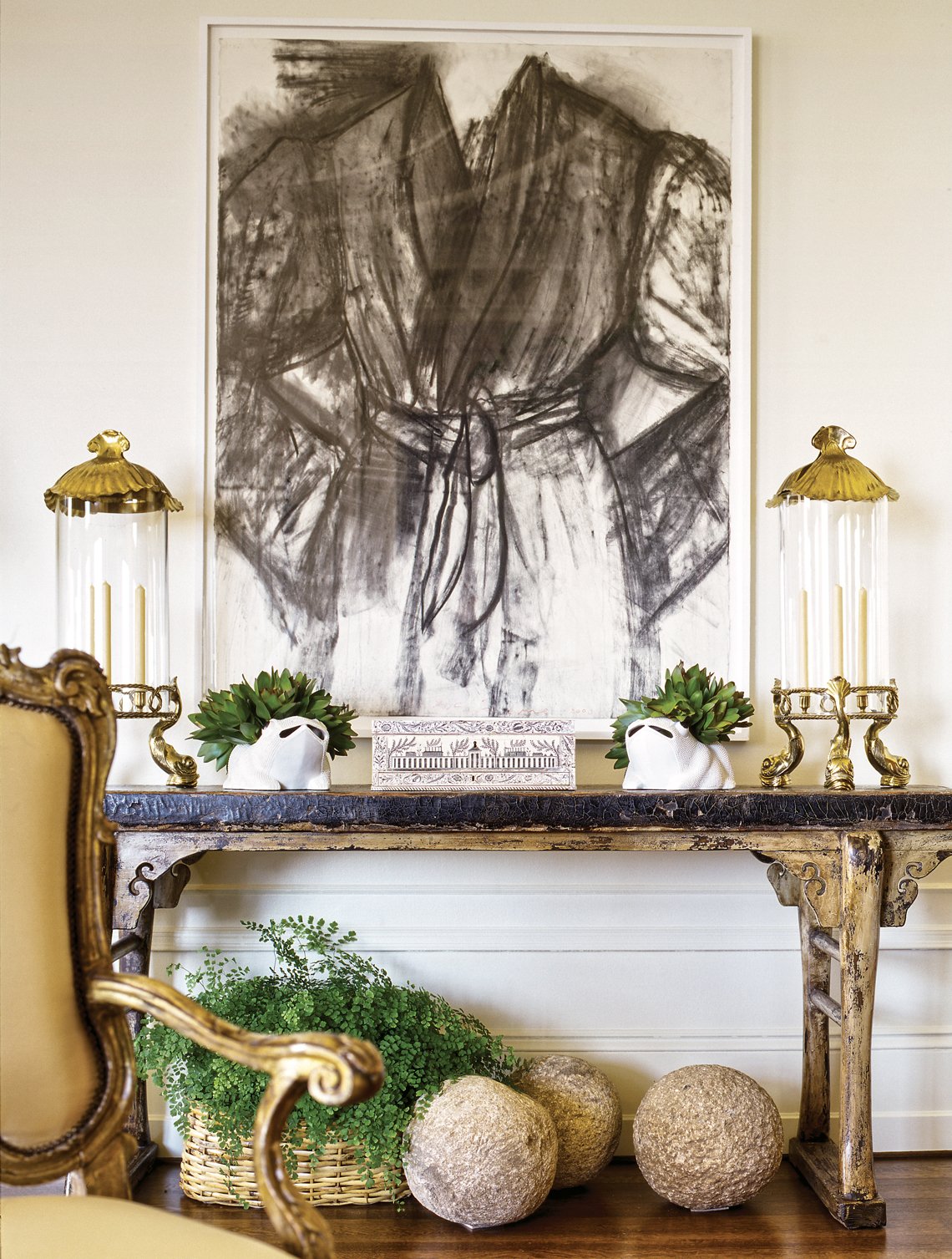 |
A trio of 17th- and 18th-century granite cannonballs from Spain lend a sculptural element and crusty patina under an 18th-century Chinese altar table. A Jim Dine charcoal work, Untitled, 2006 hangs above. The frog planters are from the estate of legendary Hollywood set designer Tony Duquette. Photo by Matthew Millman. |
“It’s hard to go wrong with anything from the 18th century — the height of great beauty in architecture and design. But if I could only have one piece of furniture in an empty room it would be something from the Régence period .… that narrow 14-year window of incredibly chic, perfectly proportioned furniture.” |
 |
A pair of black and parcel-gilt decorated Regency armchairs (circa 1810) from the collection of renowned American interior designer Albert Hadley are mated with two reproduction chairs. They surround a Michael Taylor-designed marble octagonal table purchased from American shipping heiress Nancy Dollar’s estate sale. The painting is Visca by Gustavo Rivera. Photo by Edward Addeo. |
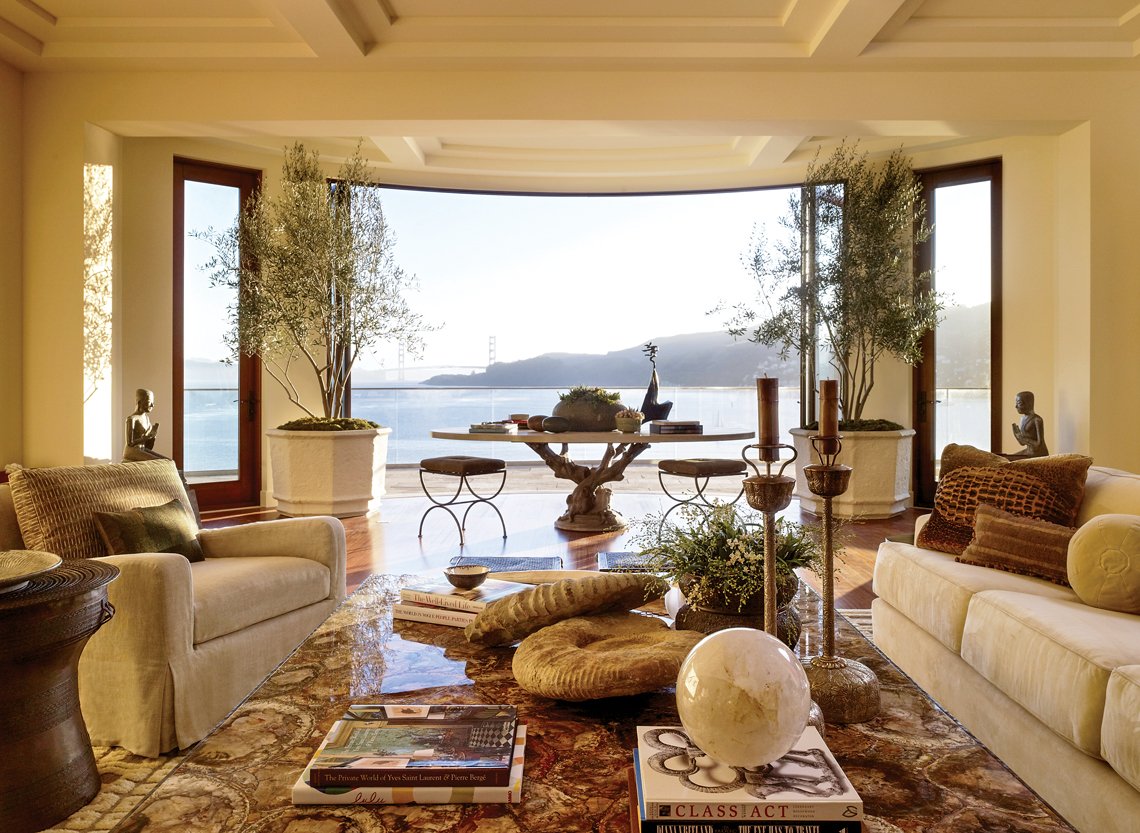 |
Nothing could compare to this amazing view of the Golden Gate Bridge, so, what better approach than to create a meditative atmosphere from which to enjoy it. The dining table base was created by Andrew Fisher of Fisher Weisman, and Suzanne Tucker designed the elliptical table top to follow the curvature of the windows. The low profile of the Maison Jansen campaign stools keeps a clear sightline to the view. The sculpture on the dining table is Small Nijinski on Anvil Point, 2001 by Barry Flanagan. A pair of antique Sukothai gilt bronze seated praying monks from the early 19th century bracket the transition from the sitting area to the dining area. In the sitting area, a highly-figured onyx-topped coffee table is styled with ammonite fossils, a marble orb, and a pair of vintage Mexican silver candlesticks. The side table is a Tibetan rain drum; the rug is 1940s Swedish half-pile. Photo by Matthew Millman. |
 |
The delicate, intricate detail in a pair of Italian neoclassical walnut and fruitwood marquetry commodes from the second half of the 19th century is echoed by the patterning on a 19th century Sultanabad rug. Similarly, the lines of the artwork, Untitled (nude) by David Smith speak to the veining of the marble-topped coffee table. Such pairings create subtle harmony and balance within groups of eclectic pieces. Photo by Edward Addeo. |
 |
A vintage 1960s Valentino jaguar coat is repurposed to cover Michael Taylor’s “Frog Chair” in this vignette from a San Francisco Bay-view living room. One of a pair of walnut, ivory and ebonized Louis XIV concave block front commodes from late 17th-century Italy is placed in front of a floor-to-ceiling mirrored panel; these flank the fireplace. The Gerbes sconce, also one of a pair, is by French furniture artist and sculptor Jacques Duval Brasseur and is signed and dated 1978. Photo by Matthew Millman. |
“Antiques resonate with history’s silent voices, and I often imagine their stories. The appeal resides in a heavily lacquered surface, in a patina only achievable with time; their very imperfections speak to me of character and life lived.” |
— from Rooms to Remember: The Classic Interiors of Suzanne Tucker |
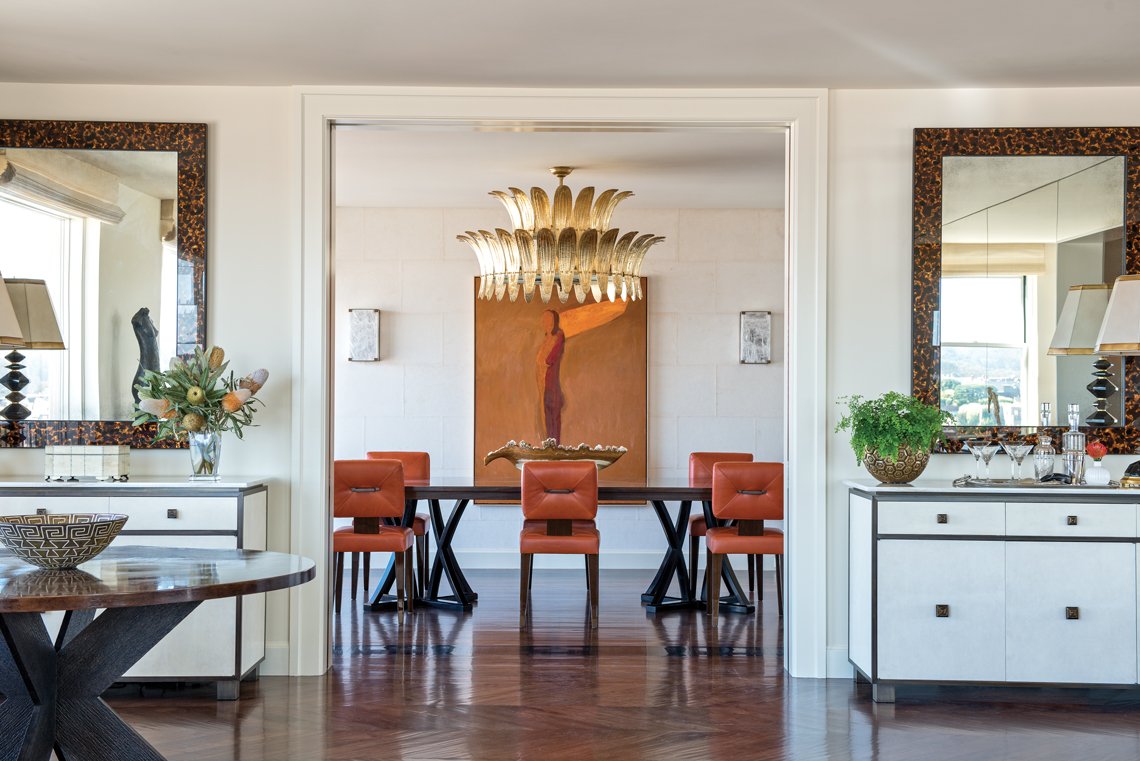 |
The view into the dining room, crowned by a gilt Murano glass and brass chandelier Un Lustre en Verre, from Galerie Glustin, Paris. The painting is oil on canvas, Untitled Figure (2010), by Nathan Oliveira, a noted member of the Bay Area Figurative Artist group, from his Angel series. Photo by Edward Addeo. |
 |
Tucker & Marks custom designed the walnut cabinetry in a bleached and waxed finish incorporating a vintage 1930s Japanese screen, motorized to conceal the television. The ceiling fixture is an antique Swedish alabaster pendant light, circa 1910. Photo by Edward Addeo. |
Tucker & Marks
58 Maiden Lane, Fourth Floor
San Francisco, CA 94108
T 415 445 6789
This article was originally published in the 2019 Anniversary/Spring issue of Antiques & Fine Art magazine, a fully digitized version of which is available at www.afamag.com.















